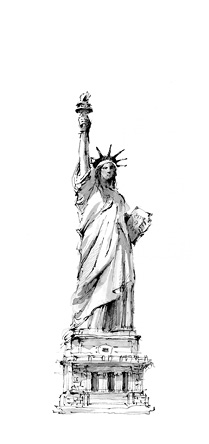

Washington Square Arch
GREENWICH VILLAGE, usually referred to as “the Village,” was originally an Indian fishing village called Sapokanican, with a stream running through it known as the Minetta, or “devil water.” The Dutch transformed it into a tobacco plantation, which under the English evolved into a country village. It was known as Grinwich from as early as 1713, named no doubt by someone who had sailed to New York from Greenwich in England. The village became a refuge during outbreaks of cholera and yellow fever in the city to the south, and often those who came temporarily to escape decided to stay. Thanks to its isolation the western portion of the village was spared inclusion in the Manhattan Grid plan and retains its winding 18th-century street layout as well as its village atmosphere. In the late 19th, early 20th centuries Greenwich Village became a haven for writers and artists, becoming America’s equivalent of Paris’s “Left Bank.” Today it is too expensive for all but the most successful artists.
Walk west on 14th Street and turn left (south) onto Fifth Avenue.
At No. 47, opposite the First Presbyterian Church, whose tower is said to be modeled on the famous Magdalen Tower of Oxford University, is the SALMAGUNDI CLUB, AMERICA’S OLDEST ARTIST’S CLUB, housed in a rare brownstone with one of the few remaining stoops on Fifth Avenue. The club was founded in the Village in 1871 as the New York Sketch Club and moved here in 1917. Its present name was inspired by Washington Irving’s satirical “Salmagundi Papers.” Past members have included Stanford White, Louis Tiffany, Childe Hassam, and William Merritt Chase. Winston Churchill was an honorary member.
On the corner west of 10th Street is the CHURCH OF THE ASCENSION, consecrated in 1841 and THE FIRST CHURCH ON FIFTH AVENUE. It was designed by Richard Upjohn as one of New York’s earliest examples of English Gothic Revival and opened five years before Upjohn’s new Trinity Church. Inside, the chancel is decorated with a huge mural by JOHN LAFARGE showing the Ascension of Our Lord. Many of the angels in the mural look remarkably like LaFarge’s mistress Mary Whitney.
In 1844 the church hosted THE FIRST MARRIAGE OF A SITTING PRESIDENT when the tenth U.S. president JOHN TYLER secretly married his second wife, JULIA GARDINER, a young socialite from one of New York’s oldest families and 30 years his junior. Tyler is best remembered as THE FIRST VICE-PRESIDENT TO ASCEND TO THE PRESIDENCY, which he did in 1841 after William Henry Harrison died of pneumonia caught while delivering his two-hour inaugural speech in freezing weather.
At Nos. 11–15, the Brevoort Apartments stand on the site of FIFTH AVENUE’S FIRST HOTEL, the BREVOORT HOTEL, built in 1851 and famous for NEW YORK’S FIRST SIDEWALK CAFÉ, where village characters such as Eugene O’Neill, Isadora Duncan, and Edna St. Vincent Millay would congregate. Aviator CHARLES LINDBERGH came here for breakfast in 1927 to collect $25,000 from the hotel’s owner Raymond Orteig, who had put up the money as a prize for the first person to fly solo nonstop across the Atlantic.
BUDDY HOLLY lived in the Brevoort Apartments after his marriage in 1958 until his death in 1959; as did CARMINE DESAPIO, the last boss of Tammany Hall.
The name “Brevoort” comes from Henry Brevoort, a landowner from Dutch stock whose house here was THE FIRST HOUSE ON FIFTH AVENUE.
A short step down West 8th Street, the New York Studio School occupies what in 1931 was the original home of the Whitney Museum of American Art.
Back on Fifth Avenue, past No. 1, is WASHINGTON MEWS, the ONLY MEWS IN NEW YORK and also THE OLDEST COBBLED STREET IN NEW YORK. It was laid out in the 1830s as stables for the big houses in the area. Some of the stables were converted into studios in 1916, with Gertrude Vanderbilt Whitney as an early tenant. The properties now belong to New York University, and although the street is gated to discourage idle sightseers, the Mews is not private and you can stroll down it if you wish.
WASHINGTON SQUARE PARK marks the start of Fifth Avenue and, as the largest green space in Greenwich Village, is a popular meeting place. It also serves as a quadrangle for New York University, THE LARGEST NOT-FOR-PROFIT INSTITUTION IN AMERICA, which owns most of the buildings around the park.
In the early 19th century the park was a “potter’s field,” or public burial ground for the indigent, and many of the victims of the yellow fever outbreak of 1822 were buried here. Some 20,000 bodies are thought to still be lying beneath the square.
In 1826 the potter’s field was leveled out as a military parade ground and by the 1830s it had become a desirable place to live. The beautiful houses along the east side of Washington Square North, along what is known as the “Row,” date from this time and form one of the first terraces to be built in New York.
HENRY JAMES’S grandmother lived “in venerable solitude” at No. 18 Washington Square North (now gone). Henry himself was born just around the corner at No. 21 Washington Place in 1843, and between the ages of four and 12 lived at No. 58 West 14th Street. His novel Washington Square, published in 1880, is set in the area during the time he was growing up here.
RICHARD MORRIS HUNT, the architect who designed the pedestal of the Statue of Liberty, the “Met,” and Carnegie Hall, lived at No. 2 Washington Square North from 1887 to 1895.
The artist EDWARD HOPPER and his wife lived in a studio on the top floor of Nos. 1–3 Washington Square North from 1913 until his death in 1967.
In 1889 a wooden arch was raised in Washington Square to celebrate the centenary of George Washington’s inauguration. It was replaced in 1892 by a permanent arch made of Tuckenhoe marble, designed by Stanford White and modeled on the Arc de Triomphe in Paris. Two statues of Washington, one as commander-in-chief and one as president, were added on the north side in 1918, along with Washington’s motto, Exitus acta probat (The end justifies the means), and the Washington family coat of arms, three stars over two stripes, inspiration for the American Stars and Stripes. A small door in the western leg of the arch gives access to a secret spiral staircase of 102 steps leading to the top, from where there would no doubt be a wonderful view, if only one were allowed to see it.
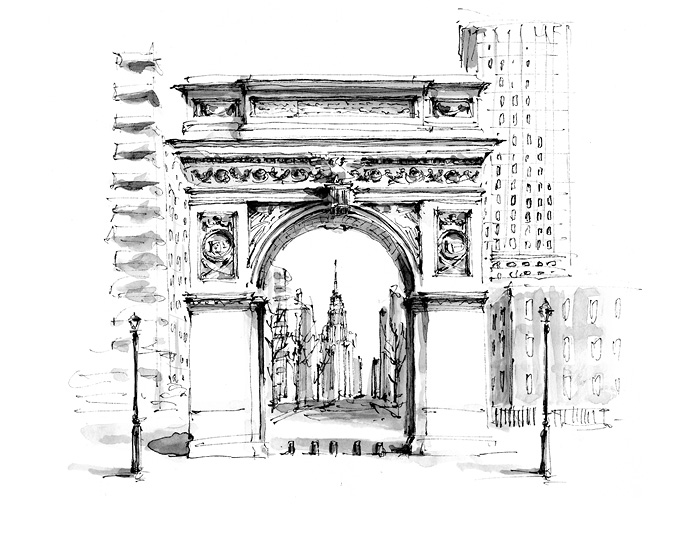
Now walk west through the park, past the statue of Italian patriot Giuseppe Garibaldi, who lived in New York in 1850–51 while in exile, and on into Washington Place, to the Brown Building on the left.
This was the site in March 1911 of the WORST INDUSTRIAL DISASTER IN NEW YORK’S HISTORY, THE TRIANGLE SHIRTWAIST FACTORY FIRE. The factory occupied the top three floors of what was then called the Asch Building, and the afternoon shift was just ending when fire broke out on the eighth floor and quickly swept through the ten-story building. While most of those on the eighth and tenth floors were able to escape, those on the ninth floor found themselves trapped as the management had locked the doors to the stairwells and exits to prevent pilferages. The elevators soon became inoperable and the poorly maintained fire escape collapsed, sending scores of women plunging 100 ft (30 m) to their death on the street below. When the fire department arrived their ladders couldn’t extend above the sixth floor, and the remaining workers were left to either jump or burn to death. One hundred and forty-six people died, most Italian immigrant women. The tragedy prompted legislation for major improvements in safety in the workplace, championed largely by the International Ladies Garment Workers Union. One of those watching in horror as the women fell to their deaths was FRANCES PERKINS, who determined that day that she would fight for improved conditions for workers. She later became THE FIRST WOMAN EVER APPOINTED TO A CABINET POSITION IN AMERICA when Franklin D. Roosevelt made her secretary of labor in 1933.
Now return to Washington Square and walk to the southern exit to see the Judson Memorial Church on the corner of Thompson Street. This fine Romanesque-style church was built in 1892 by Stanford White and is named after Adoniram Judson, THE FIRST AMERICAN MISSIONARY TO BE SENT ABROAD, in his case to Burma in 1811. The church is mostly renowned for its collection of stained glass windows by John LaFarge, who did the mural in the Church of the Ascension on West 10th Street. A window on the second stair landing called “Praying Angel” is another depiction of LaFarge’s mistress Mary Whitney.
Walk to the southwest corner of Washington Square, where the chess players sit, and where the 1993 movie Searching for Bobby Fisher was filmed, and turn left (south) into MacDougal Street, named after New York senator Alexander McDougall. Playwright EUGENE O’NEILL moved into a room in the boardinghouse at No. 38 on the corner in 1916 when his first work, Bound East for Cardiff, was being staged by the Provincetown Players in a converted parlor at No. 139. The Players eventually moved into an old stable at No. 133, which they made into the PROVINCETOWN PLAYHOUSE, and many more of O’Neill’s plays were staged there. PAUL ROBESON made an early stage appearance there in 1922, and BETTE DAVIS made her stage debut there in 1929. In 1960 the theater was the scene of the first production of Edward Albee’s first play, The Zoo Story.
Down at the end of West 3rd Street to your right is GOLDEN SWAN PARK, which marks the former site of the GOLDEN SWAN CAFÉ, a rough, run-down Irish dive with sawdust on the floor better known as the Hell Hole and patronized by gamblers, gangsters, Tammany Hall politicians, and assorted misfits. Eugene O’Neill loved to drink there and pick up material for his plays, and he later immortalized the Hell Hole as Harry Hope’s saloon in The Iceman Cometh. The bar was demolished, or fell down of its own volition, in 1928.
Back on MacDougal Street, LOUISA MAY ALCOTT finished writing Little Women while living at Nos. 130–132 between 1867 and 1870.
Across from there is the CAFÉ REGGIO, established in 1927 and THE FIRST CAFÉ IN AMERICA TO SERVE CAPPUCCINO. The café is featured in a number of films, including The Godfather II, Serpico, and the first Shaft movie. In 1959 presidential hopeful John F. Kennedy gave a speech on the sidewalk outside.
The CAFÉ WHA?, on the corner of Minetta Lane, is where BOB DYLAN played his debut gig in 1961. Others who began their careers here include Jimi Hendrix; Bruce Springsteen; Peter, Paul and Mary; Kool and the Gang; Richard Pryor; and Bill Cosby. Although it has changed hands several times, the Café Wha? remains a groundbreaking venue for up-and-coming performers.
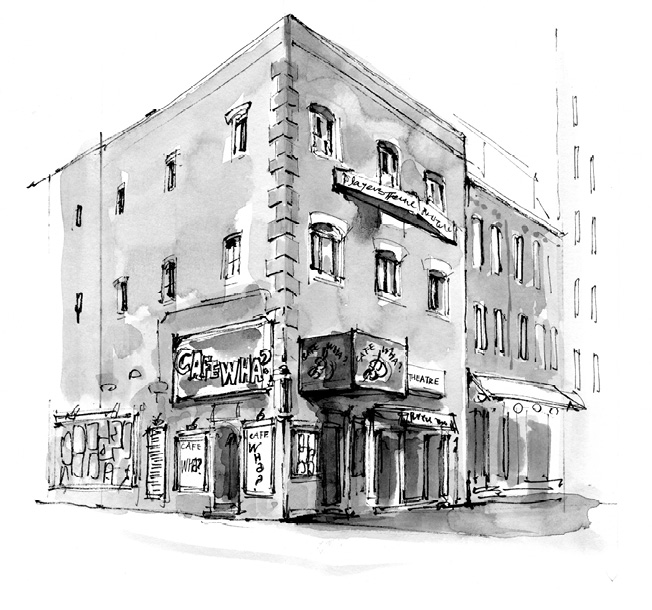
Across Minetta Lane is the MINETTA TAVERN, a popular haunt for Ernest Hemingway, F. Scott Fitzgerald, Dylan Thomas, and Ezra Pound. During Prohibition it was a speakeasy called the Black Rabbit. THE READER’S DIGEST was founded in the basement in 1922 by DeWitt Wallace and his wife Lila Bell.
Now walk down Minetta Lane and turn left into Minetta Street—these two roads run along the course of the now hidden Minetta Brook. At the end of Minetta Street cross Sixth Avenue to Bleecker.
DOWNING STREET, running southwest off Bleecker and Sixth, is named after diplomat Sir George Downing, who was responsible for arranging the handover of New Amsterdam to the British in 1664. The little square next to it is called Sir Winston Churchill Square in honor of the British prime minister who lived in No. 10 Downing Street in London (named after the same Sir George Downing).
Continue north on Bleecker as far as Jones Street, unchanged since Bob Dylan and his girlfriend Suze Rotolo strolled down it in the photo on the cover of his early album The Freewheelin’ Bob Dylan.
Cross back over Bleecker left and right and go down Morton, then left and right over Seventh Avenue into Leroy, which leads to . . .
On its north side St. Luke’s Place is lined with a row of rather nice 1850s townhouses. No. 10 was the home of the Huxtable family in THE COSBY SHOW, and No. 6, marked by the two tall lamps that identify mayoral homes in New York, was the home of the popular, high-living, “anything goes” MAYOR JIMMY WALKER, whose hedonistic lifestyle of women, drink, and easy money was brought crashing down by Robert Moses and the Great Depression. Walker, after whom the park opposite is named, resigned in 1932 and fled to Europe, while his house was sold to settle his unpaid tax bill.
Now turn right on Hudson and then right again into Morton Street. No. 66, with the distinctive angular bow window, is a favorite movie location, where Harrison Ford lived in Working Girl, Winona Ryder lived in Autumn in New York, and Matthew Broderick lived in The Night We Never Met.
Opposite, at No. 65, is where the alleged Soviet spies JULIUS AND ETHEL ROSENBERG lived. Accused during the height of the McCarthy era of passing secrets about the atomic bomb to the Russians, they were executed in 1953, THE FIRST U.S. CIVILIANS EVER TO BE EXECUTED FOR ESPIONAGE.
Film director SOFIA COPPOLA has lived at No. 46, an Italianate townhouse built in 1854 at a bend in the street. Narrow at the front, the house widens toward the rear and has a huge back garden.
At the junction turn hard left into . . .
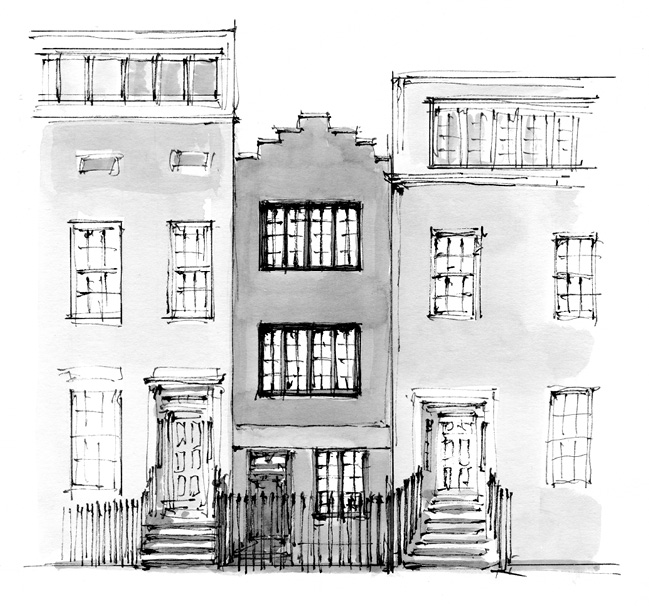
At No. 751/2 and marked by a plaque is the “NARROWEST HOUSE IN THE VILLAGE,” just 91/2 ft (2.9 m) wide and built in 1873 to fill an alleyway. The poet EDNA ST. VINCENT MILLAY lived here in 1923–24, then the actor JOHN BARRYMORE, and later CARY GRANT.
Next to it, on the corner at No. 77, is the ISAACS-HENDRICKS HOUSE, the OLDEST HOUSE IN THE VILLAGE, dating from 1799. John Isaacs, who built the house, was a wholesale merchant. The second owner, Harmon Hendricks, cornered the colonial copper market along with his associate Paul Revere and provided the copper for the engines of Robert Fulton’s steamboat the Clermont.
Just around the corner on Commerce Street is the CHERRY LANE THEATER. Built in 1836 as a brewery, and then a tobacco warehouse, it was converted into a theater in 1924 by Edna St. Vincent Millay.
BEA ARTHUR, Dorothy in The Golden Girls, made her professional debut here in 1947. TONY CURTIS was discovered here by a scout from Universal Pictures in 1948 while playing the lead role in Clifford Odet’s Golden Boy. In 1958 Samuel Beckett’s Endgame had its American premiere here, and in 1961 the theater staged the world premiere of Beckett’s Happy Days.
Return to Bedford Street and continue north. The small, unmarked brownstone at No. 86 is the home of CHUMLEY’S, New York’s most famous speakeasy, which was founded by Leland Chumley in 1922, and frequented by the likes of F. Scott Fitzgerald, who had a regular table, Edna St. Vincent Millay, Eugene O’Neill, Norman Mailer, and Allen Ginsberg. Deliberately anonymous, Chumley’s closed for repairs after a fire in 2007 and did not reopen until 2013.
Continue up Bedford and cross over the junction with Grove Street. Now turn and look back at the building on the left of Bedford at No. 90. This is the “Friends” Building, where Rachel, Monica, Phoebe, Joey, Chandler, and Ross all lived at one point or another, in the television series Friends. Although the series was shot in a studio in Los Angeles, the exterior of this building is shown many times in each show to establish that this is where the series is actually set.
On the corner across Grove from the Friends building is the gorgeous WILLIAM HYDE HOUSE, the only large wooden house in Manhattan still in private hands. It was built in 1822 by window sash maker William Hyde as a full-size advertisement for his work, and his workshop still stands behind the house on Bedford Street.
The first “speakeasy” was a saloon bar outside Pittsburgh run illegally by a woman named Kate Hester, who refused to keep paying for a liquor license when the price rose from $50 to $500 in 1888. If her customers became too noisy and risked attracting attention to the bar, she would exhort them to “speak easy, boys, speak easy.”
Turn left (south) onto Grove Street, leaving the William Hyde House behind on your right, and look to your left as the road bends. At the end of a small-gated passageway are six small townhouses constructed in 1854 as infill for the space left by the bend. Officially named GROVE COURT, this became known as “Mixed Ale Alley” since the houses were built for people too poor to afford ale other than the mixings at the bottom of the barrel. Today you would need to own a whole brewery to be able to afford to live there.
Carry on down Grove and cross Hudson to the CHURCH OF ST. LUKE IN THE FIELDS, an Episcopal church built in open countryside in 1822 for the people of Chelsea and Greenwich Village who couldn’t get downtown to Trinity Church. One of the founders was Clement Clarke Moore, owner of much of Chelsea and author of “Twas the Night Before Christmas.” The church was named after St. Luke, the physician evangelist, in recognition of the Village’s role as a haven from New York’s yellow fever epidemics. The church is surrounded by two acres (0.8 ha) of beautiful gardens laid out in 1950 by Barbara Leighton, a secret oasis of lush greenery and wild plants that, remarkably, is open to the public.
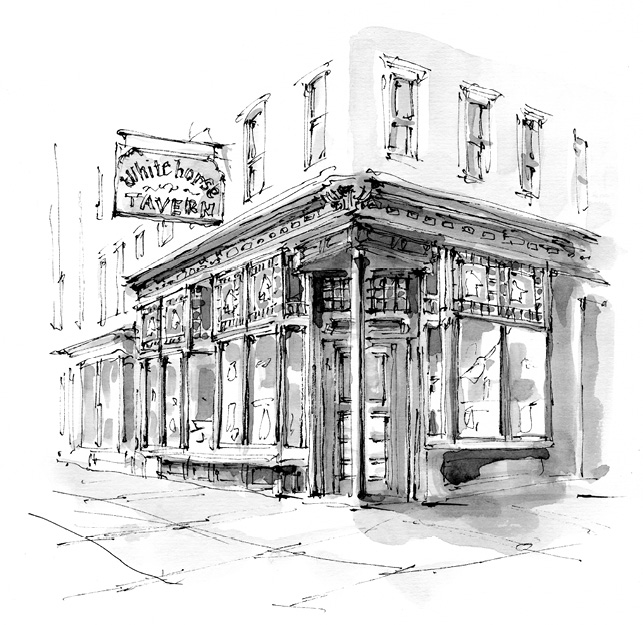
Four blocks north on Hudson Street is one of Greenwich Village’s oldest pubs, the WHITE HORSE TAVERN, established for longshoremen in 1880 and the place where DYLAN THOMAS drank himself to death in 1953, knocking back, he claimed, “eighteen whiskeys” in a two-hour drinking session. However many it was, they didn’t sit well with the pills he was taking for his depression, and the next day he collapsed at the Chelsea Hotel and died not long afterward in St. Vincent’s Hospital. The White Horse was also a favorite of writer JACK KEROUAC, a leading light with Allen Ginsberg of the 1950s Beat Generation, who rejected the drab conformity of their era and pursued a bohemian lifestyle of drugs, promiscuity, and alternative expression through art and writing. Kerouac was thrown out of the White Horse almost nightly. Other literary figures who drank here were ANAÏS NIN and MALCOLM LOWRY, while NORMAN MAILER got the idea for the free alternative weekly newspaper, VILLAGE VOICE, during a session here.
Retrace your steps down Hudson and turn left back into Grove Street. Walk on past the William Hyde House. The unusual pink-brick mansion at No. 45, built in the 1830s Federal style and the only one of its kind left in the Village, is where John Wilkes Booth plotted the assassination of Abraham Lincoln with his coconspirators. It also played Eugene O’Neill’s house in the Warren Beatty film Reds.
At No. 57 is ARTHUR’S TAVERN, established in 1937 and THE OLDEST CONTINUOUSLY OPERATING JAZZ CLUB IN NEW YORK. Charlie Parker and Roy Hargrove played there regularly.
Next door at No. 59 is MARIE’S CRISIS CAFE, on the site of the small wooden farmhouse where political theorist and revolutionary THOMAS PAINE died in 1809. The café, which is also a piano bar, gets its name from previous owner Marie Dumont and Paine’s American Crisis pamphlet series (beginning “These are the times that try men’s souls . . .”).
Now cross Seventh Avenue to Christopher Park, considered to be the heart of Greenwich Village and named after Charles Christopher Amos, a developer who laid out many of the streets in the area. Confusingly, Christopher Park has a statue of Union general Philip Sheridan in it, while Sheridan Square to the south just has some (very nice) trees. On the other side of Christopher Park, on Christopher Street, is the STONEWALL INN, a gay bar set up in 1967 by a small-time Mafia boss called “Fat Tony” Lauria. Despite Mafia protection and kickbacks to the local police, gay bars were still subject to occasional raids in those days, and in the early hours of June 28, 1969, eight police officers entered the Stonewall Inn and demanded to see everyone’s identification. A scuffle followed that spilled out onto the street and attracted a hostile crowd who pelted the police officers with bottles until they had to barricade themselves in the bar. The policemen were eventually rescued by more police in full riot gear who took the opportunity to beat up some of the crowd. There were similar disturbances over the next few nights between the police and gays demanding their right to congregate freely, and the riots marked the dawn of the Gay Liberation movement. Today New York’s annual Gay Pride March, the biggest parade in the city, takes place in June on the Sunday nearest to the anniversary of the Stonewall riots. The gay lobby group Stonewall takes its name from here too.
THOMAS PAINE (1737–1809) was born in Norfolk in England and emigrated to America in 1774 so that he could participate in the American Revolution. In January 1776 he wrote a pamphlet called Common Sense, urging the colonists to fight for independence, and it became the best-selling book in terms of sales per head of population in American history. The future president John Adams wrote, “Without the pen of the author of ‘Common Sense,’ the sword of Washington would have been raised in vain.”
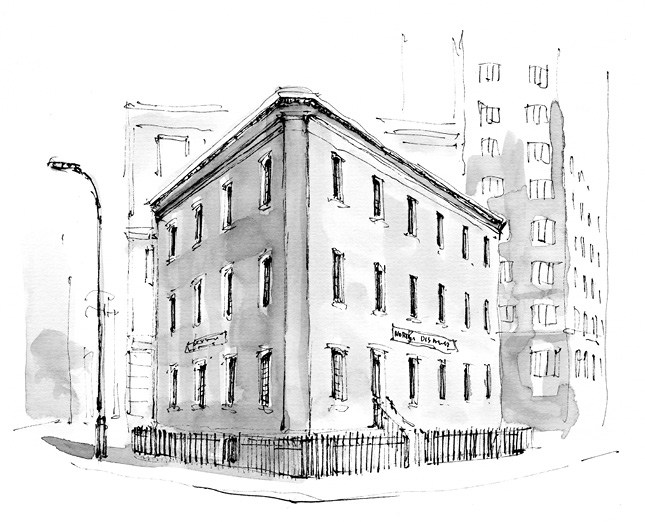
With the Stonewall Inn on your left, continue up Christopher Street to the tip of Christopher Park and turn right in front of the handsome NORTHERN DISPENSARY into Waverley Place, named after the popular “Waverley” novels of Sir Walter Scott. The dispensary was built in 1831 to provide health care for the poor of Greenwich Village who couldn’t make it to the dispensary downtown at City Hall. EDGAR ALLAN POE was treated there for a head cold in 1837 caught, no doubt, while traipsing around cemeteries looking for plots for his horror stories.
The dispensary occupies a curious triangular plot that means two sides are on one street, Waverley Place, while the other one side is on two streets, Grove and Christopher Streets.
Continue down Waverley Place and take the first left into Gay Street, where in 1926 Mayor Jimmy Walker set up his showgirl mistress, Betty Compson, in an apartment. Turn right onto Christopher Street, then left onto Greenwich Avenue and right onto West 10th Street. Half a block up on your left is one of New York’s hidden gems . . .
PATCHIN PLACE is a gated, tree-lined cul-de-sac with a row of ten brick houses built around 1848 and almost unchanged ever since. At the far end of the alley, and glimpsed only darkly, is a real treasure, NEW YORK’S ONLY SURVIVING 19TH-CENTURY GAS STREETLAMP. It still works but is now powered by electricity.
Located right in the middle of the Village and yet affording privacy, PATCHIN PLACE became a haven for writers. The poet E. E. CUMMINGS lived at No. 4 from 1923 until his death in 1962 and spent much of his time banging on the window of No. 5 to see if his neighbor, the reclusive poet DJUNA BARNES, was still alive. JOHN REED, the communist activist writer, lived at No. 1, with his wife Louise Bryant, during his final few years, while finishing off his eyewitness account of the Bolshevik revolution, Ten Days That Shook the World. He died, aged 33, in 1920. The book, and Reed himself, were the subject of Warren Beatty’s 1981 film Reds.
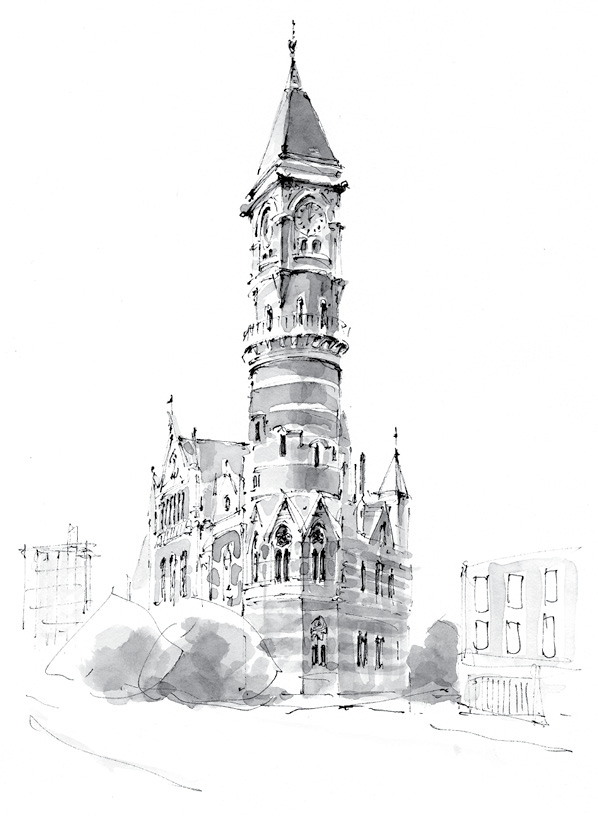
The great Victorian Gothic pile on the corner of West 10th Street and Sixth Avenue that is JEFFERSON MARKET COURTHOUSE is consistently voted one of the top ten most beautiful buildings in New York. It was built in 1876 on the site of a fire bell tower and a produce market named after Thomas Jefferson. The old fire bell was installed in the clock tower and the whole edifice was designed to look like a church, a sort of “cathedral of justice,” complete with tympanum over the doorway showing not Christ and the Apostles, but the courtroom scene from the end of Shakespeare’s The Merchant of Venice. In its early days the Courthouse was kept busy dealing with miscreants from the rowdy theater district at nearby Madison Square, but by the 1950s it had been abandoned and was threatened with demolition. A successful preservation campaign was launched, led by e. e. cummings from nearby Patchin Place, and the courthouse was reopened in 1967 as a branch of the New York Public Library.
Now cross Sixth Avenue and continue east on West 10th Street to No. 45, the Peter Warren. This 11-story apartment block was put up in the 1950s on the site of the Tenth Street Studio Building, built in 1858 by the architect Richard Morris Hunt to house THE FIRST ARCHITECTURAL SCHOOL IN AMERICA, as well as studios for American artists and his own office. This studio and others that sprang up around it were hugely influential in establishing Greenwich Village as a place for artists of all kinds. Actress Julia Roberts has an apartment in the Peter Warren.
On the opposite side of the street, the converted stable at No. 50 was the home in the 1960s of playwright EDWARD ALBEE, who bought it with the proceeds from his hit play Who’s Afraid of Virginia Woolf? He wrote Tiny Alice and his Pulitzer Prize–winner A Delicate Balance while living here. In 1968 Albee sold the house to composer and lyricist JERRY HERMAN, who bought it with the proceeds from Hello, Dolly! and Mame.
Now continue on West 10th, lined with some of New York’s loveliest houses, past No. 18, once the home of the poet EMMA LAZARUS, author of the words “Give me your poor, your huddled masses,” and No. 14, where MARK TWAIN lived from 1900 to 1901.
Cross over Fifth Avenue and continue along East 10th Street to Broadway, where you turn left and finish the walk at Union Square.
Well, I never 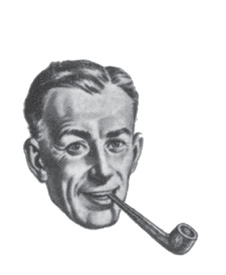 knew this
knew this
about
GREENWICH VILLAGE
Fifth Avenue used to pass through Washington Square to become West Broadway, but in 1952 residents campaigned successfully to have the square made traffic free.
Washington Square Park is where Corrie, played by Jane Fonda, wanted to be Barefoot in the Park.
As well as students, budding guitarists, painters, and poets, you may at any time, or more particularly in spring, find yourself sharing Washington Square Park with a red-tailed hawk or two. A pair of hawks named Bobby and Violet took up residence on a 12th-floor ledge of the Bobst Library on the southeast corner of the square a few years ago. Violet died and was replaced by Rosie, and every year birdwatchers gather in the square to see their new chicks learn to fly. The birds are quite unfazed by people and can often be seen at close quarters grubbing for worms on the grass or perched on the lower branches of a tree, keeping a beady eye out for unwary squirrels. A webcam operated by the New York Times keeps an eye on the nest.
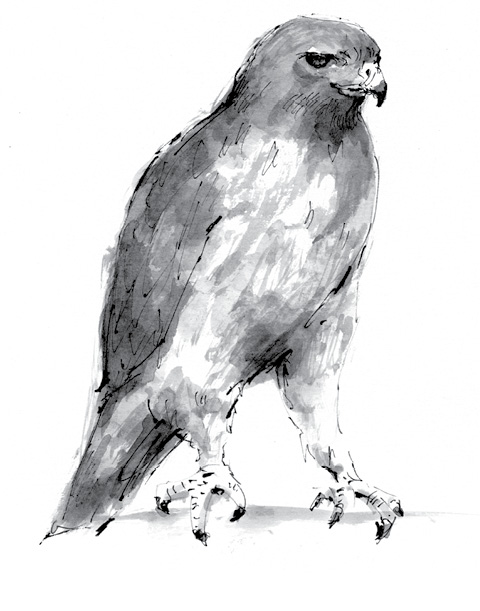
The last tree before you exit Washington Square Park at the northwest corner is an ancient English elm marked with a green plaque that says HANGMAN’S ELM. Folklore has it that highway robbers and other miscreants were hanged from this tree in the 18th century and then buried in the potter’s field. Whether or not this is true, the tree is reckoned to be at least 350 years old and is certainly the most ancient living thing in Greenwich Village.
Meg Ryan and Billy Crystal meet up under the Washington Arch in When Harry Met Sally, and Harold Lloyd drives a horse-drawn trolley through the archway in the silent movie Speedy.
In 1954 playwright EDWARD ALBEE was visiting a bar on West 10th Street when he saw scrawled on a cloakroom mirror the words “Who’s Afraid of Virginia Woolf?” and thought the phrase might make a good title for a play about living life without false illusions. He determined from that moment that he was one day going to live on West 10th himself, and fittingly he finally achieved it thanks to the success of Who’s Afraid of Virginia Woolf?
